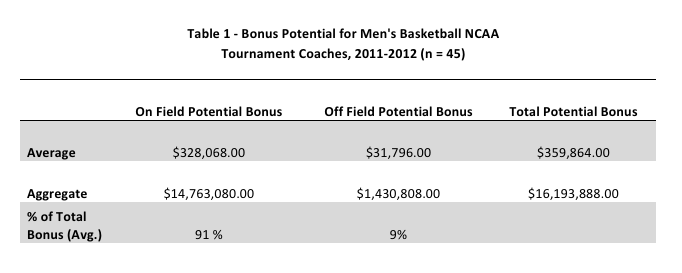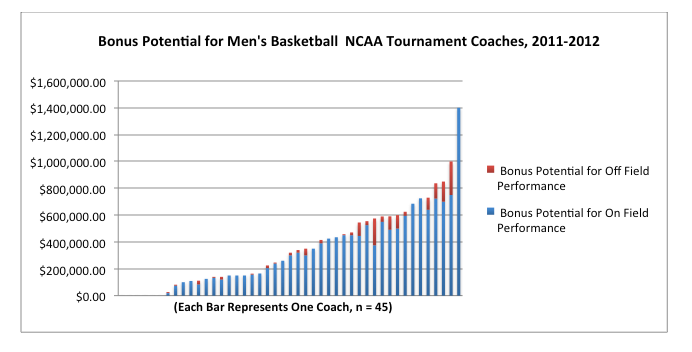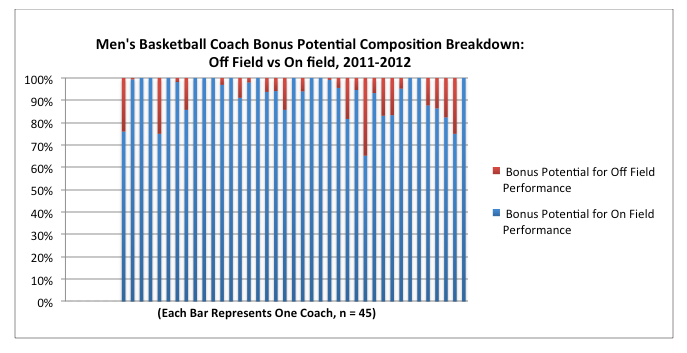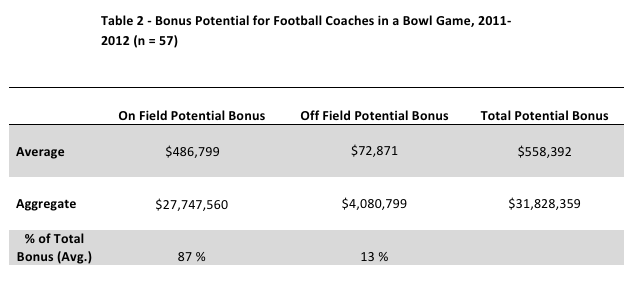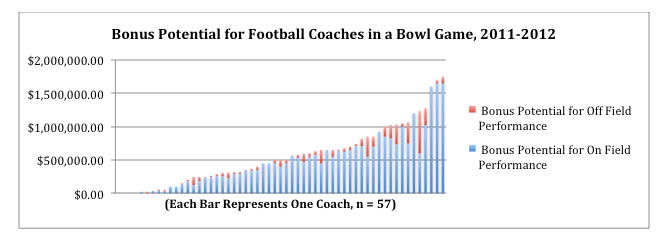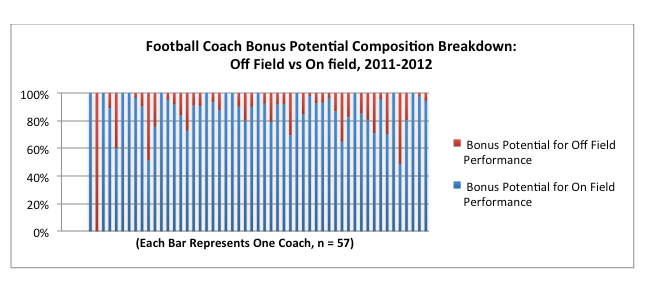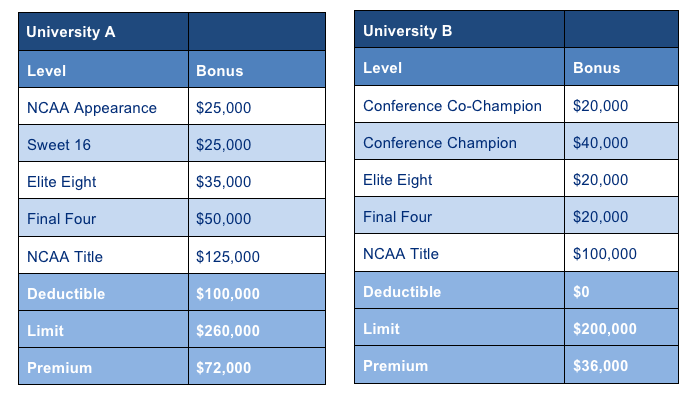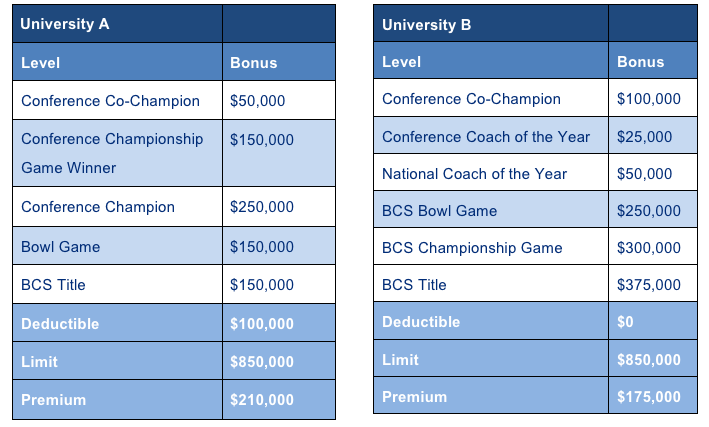Head coaches’ salaries increased at a faster pace than total revenue in the 2012 fiscal year ending June 30th, a rate of 11.7% versus 5.7%. This presents a problem, in terms of revenues, for top-tier athletic departments when performance is measured against attendance in both football 1 and men’s basketball 2, and has left many programs scrambling to mitigate risk while not scuttling competitiveness. As with any area where financial risk must be balanced against aggressiveness, insurance provides one way to both provide incentives and protect against crippling payouts. This solution would allow programs to increase the bonus component ( for competition bonuses , including attendance) of select coaches’ compensation in a fiscally creative way. Traditionally large-budget programs in the D-I can maintain market competitiveness and mid-majors would be able to provide the incentives of deferred compensation and liquidated damages buyout within the structure and provisions of coaching contracts. 3
Rather than accruals for bonus compensation, the use of insurance as risk mitigation tool comes at a set cost (the insurance premium). If the premium is less than the cost of paying out a bonus, then insurance may be a worthwhile expenditure to consider. 4 On the other hand, it would not make sense for a program to incur the expense of a premium if there is a low likelihood of the coach achieving a bonus. 5
Beyond weighting the probabilities of coach performance, another factor to consider (essentially, where the creative value of this idea may pay off beyond the direct tangible fiscal benefits): is the cost of coverage helpful to retain (i.e., as a part of a retention package, making it potentially more expensive for other programs to compete with a total compensation package where the contingent component is insurance backed) and/or motivate a coach (with a competition bonus).
This article will review bonus data from the Win AD coaches database to set a baseline (Part I) and then examine several actual quotes (anonymized) from the 2011-12 season to assess the viability of this tool.
Part I – Bonus Compensation, 2011-12 Season – Head Football and Men’s Basketball Coaches
Table 1 and Table 2 reflect the most recent potential bonus compensation levels for two sample populations.
Part II – Sample Quotes and Bonus Amounts To Be Insured (if coverage bound)
With this snapshot of two relevant populations and sports in mind, we asked John Lakowski (812-340-0706 / John.Laskowski@marshpm.com) and Wesley Kee (wesley.kee@marshpm.com) at Marsh insurance to share some insights about quotes that were provided in the 2011-12 season. The following are a few real life examples (anonymized) to illustrate what the premium cost would have been compared to the total bonus amount that was quoted for insurance coverage. Also, we have provided examples of additional current bonus arrangements and quotes received for the 2012 policy year.
2011 Client Snapshot
Client One (Purchased Coverage)
- Bonus Incentive: $500,000
- Amount Insured: $500,000
- Premium: $112,000
- Total Actual Client Savings: $388,000
“In this instance the school purchased a policy to cover their incentivized contractual obligation of $500,000, with an insurance premium quoted at $112,000. The team came together to have a very successful season. Congratulations were in order for the coach, who leveraged the most from his players and he earned the entirety of his bonus—the full $500,000. Because the institution believed in achieving their full potential, and had the foresight to purchase insurance coverage, the athletic department saved $388,000. Happy coach, happy team, happy A.D.”
Client Two (Declined the Coverage)
- Potential Bonus Incentive: $650,000
- Amount Insured: $650,000
- Premium: $25,000
- Actual Bonus Coach Earned: $25,000 for NCAA Appearance, $25,000 for Sweet 16, & $35,000 for Elite 8
- Potential Savings: $ 60,000
“This school took a slightly more pessimistic view of their chances during the pre-season. Their head coach was promised $650,000, but the institution budgeted for the expense internally, deciding not to purchase insurance coverage. Not quite a Cinderella season, but exceeding the gloomy expectations of the pre-season the coach earned $85,000 of the bonus. A calculated risk, if the institution would have gone with the initial insurance policy, they would have saved their athletic department $60,000.”
2012 Basketball Quotes
“Here is a situation (University A) where tough decisions must be made. This Division 1 men’s college basketball team had all the hype going into the season, expectations of a great year. The total bonus potential sits at $260,000, a significant cost if the team lives up to the experts’ prognostications. The school’s premium reflects those high expectations and comes in at $72,000, with a $100,000 deductible. This would ensure at most an $88,000 insurance payout if the team succeeds. Because of the high premium and deductible the school will probably budget internally for the bonus and hope for the best.
“It doesn’t get easier for University B. In rebuilding mode, this Division 1 men’s b-ball team was not a favorite going into the season. Despite promise on the horizon, anticipations for this season were low and that was reflected in their quote. There was the potential for $200,000 worth of bonuses paid out to the coach, but their premium came out to only $36,000, with no deductible. Now the team must decide whether to skimp on the coverage and hope they do indeed underperform, or be safe and dream of a Cinderella.”
2012 Football Quotes
“University A’s football team had it slightly easier. The pundits liked them, the fans were excited, and the speculation was that they’d be serious challengers. While the school examined their finances and what the budget allowed, the quote was given some careful consideration. The premium ($210,000) and deducible ($100,000) were significant, but a ride to a BCS title would have saved the school $540,000, while even a conference championship and bowl-game appearance would have saved $90,000. It was probably best to lay the chips down, roll the dice, and see how far that horse could carry them!”
“Unfortunately, University B’s football team was not enjoying such a sublime run. The coach had a track record, as indicated by the incentive clauses in his contract, but the expectations were for a disappointing season. On the one hand, this resulted in a low premium and no deductible, making the team a plausible buyer of coverage. On the other hand these incentives may have been simply lottery tickets with no foundation in reality. The school should have probably hunkered down, rebuilt, and budgeted internally for this miserable season. “
Part III – Observations and Closing Thoughts
As athletic departments plan their budget each year, the use of insurance as risk mitigation is a valuable tool because it is a set cost (the insurance premium). Additionally, by utilizing this coverage, it enables programs to be more creative with performance incentives while building an environment where programs can motivate and inspire the best personnel to do even better! The coach wins by receiving an attractive bonus and the school wins by reaping the rewards of their inspired performance.
Each school must evaluate past experience, current bonus arrangements, and the competitive landscape of each sport to determine whether contract bonus insurance would be beneficial. Getting a quote is free, however, and can be done each year to coincide with the school’s budget process. It’s important to note that coverage tends to be less expensive the earlier the quote is requested.
References:
-
http://www.sportsbusinessdaily.com/Daily/Issues/2012/05/08/Research-and-Ratings/Spring-Games.aspx
http://www.usatoday.com/sports/college/football/story/2012-01-03/college-football-bowl-attendance/52368758/1 ↩
-
http://chronicle.com/blogs/players/big-basketball-attendance-swings-among-division-i-programs/29814
http://www.usatoday.com/sports/college/mensbasketball/story/2012-03-08/college-basketball-concerns-attendance-drop/53424996/1 ↩
- http://www.nytimes.com/2012/01/01/sports/ncaafootball/contracts-for-top-college-football-coaches-grow-complicated.html?pagewanted=all ↩
- Where underwriting assigns a lower cost of coverage for coaches of teams with a fair to good chance of achieving bonus targets, such program favorable arbitrage situations could mean ADs could offer significant bonus compensation at a low cost through insurance. ↩
-
We are not suggesting that this idea has fiscal appeal for coaches whose performance is not reasonably likely to result in the achievement of bonus performance compensation. Rather, this approach should be focused on coaches whose performance is more probable to trigger payment of the bonus component of total compensation. ↩


